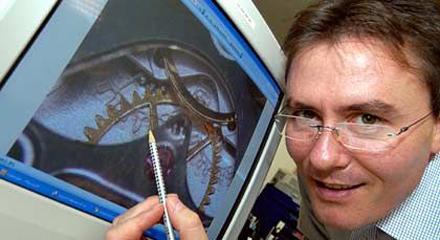
Press, Manager Magazin, 2004.08. ➜ Scientists have come up with a new twist to make mechanical watches run even more precisely and need to be wound less often. In the future, cogwheels could be made of artificial diamonds.
Ulm – Scientists in a laboratory in Ulm have produced the world’s first gear wheels made of artificial diamonds for a mechanical watch. The web width of the transparent micro gears is half the thickness of a human hair, explained Peter Gluche.
The Managing Director of Ulm-based Gesellschaft für Diamantprodukte (GFD), his partner André Flöter and three other employees have been working on this world first for around one and a half years. The gears and hairspring were developed for the Swiss watch company Ulysse Nardin (Le Loche).

A spokeswoman said on request that it was not yet clear in which clock the gears would be installed. “That will be decided in the next few months.” The filigree gear wheels are produced using a gas cutting process specially developed by GFD. The components made of wafer-thin diamond platelets are etched into shape around templates.
What remains are transparent, light and elastic gear wheels and spiral springs with a very smooth surface. “Thanks to the material, the watch is more precise and needs to be wound less often,” said the 36-year-old electrical engineer Gluche.
The scientists and entrepreneurs at GFD use diamond as a raw material not only to manufacture gear wheels for watch movements. Gluche and his employees do far more business with cutting tools, which are also coated with a diamond layer and sharpened with the help of gases. “The diamond cutters are suitable for paper, wood, leather, fabrics, plastic and metal foils and show almost no signs of wear,” said Gluche. That is why the production price, which is up to ten times higher, is quickly amortized.
Source: Manager Magazin, 26.08.2004


